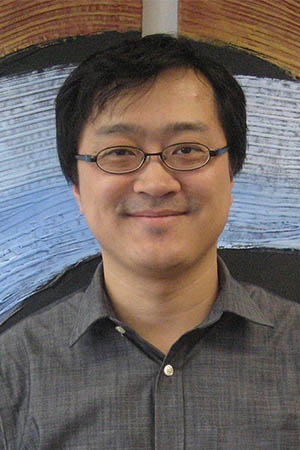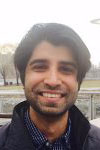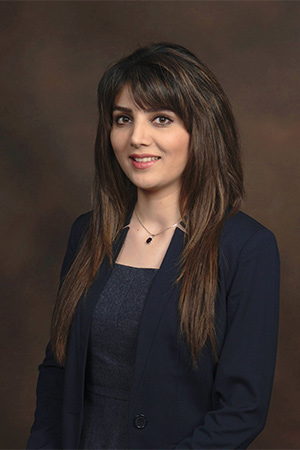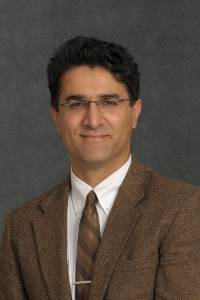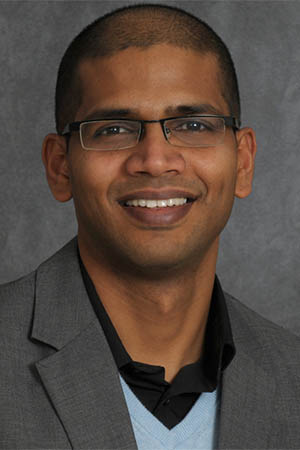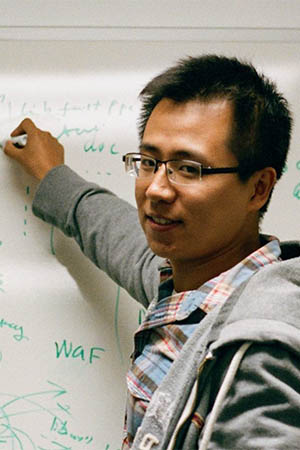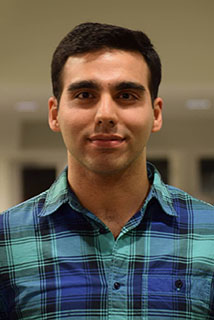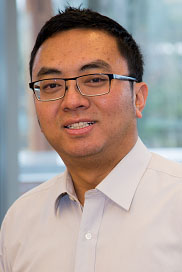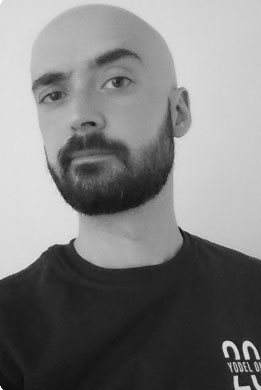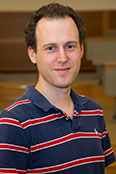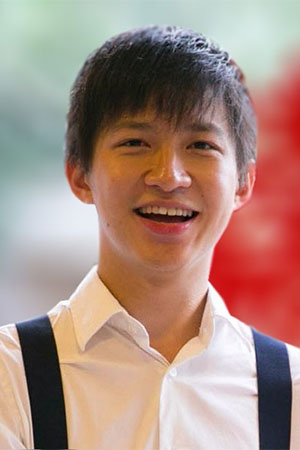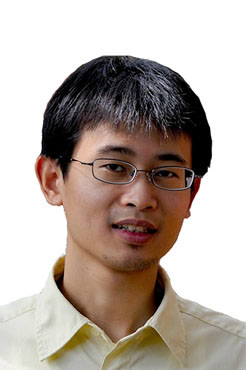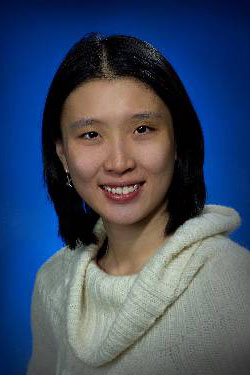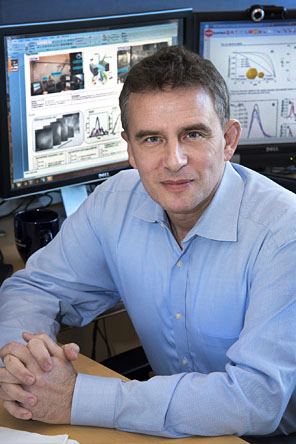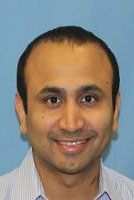CEAS New Faculty
Biomedical Engineering
2016-2017: Hassan Arbab
2016-2017
|
|
Hassan Arbab PhD, 2012, Electrical Engineering and Nanotechnology, University of Washington |
|
|
|
The research projects in Dr. Arbab's group are focused on the invention of new terahertz emission, detection and imaging technologies and their applications in biophotonics, medical imaging, non-destructive testing, material characterization and stand-off detection of chemicals. Their work spans electro-optic theory development, modeling, instrumentation and imaging signal processing techniques. |
|||
Biomedical Informatics
2018-2019: Chao Chen
2016-2017: Romeil Sandhu
2018-2019
|
|
Chao Chen PhD, 2009, Rensselaer Polytechnic Institute BS, Peking University, China |
|
|
|
Dr. Chen explores geometric and topological properties of data. These global and robust information can provide insight for modern data analytics. His research draws from the following different domains:
|
|||
2016-2017
|
|
Romeil Sandhu PhD, 2010, Georgia Institute of Technology |
|
|
|
Dr. Romeil Sandhu is currently an Assistant Professor in the Biomedical Informatics Department at Stony Brook with affiliations/adjunct in the Computer Science and Applied Mathematics & Statistics Departments. Prior to joining Stony Brook, he received a Ph.D. from Georgia Tech in Electrical Engineering and subsequently formed a startup in missile defense (with successful exit). He returned to academia as a post-doctoral fellow in Computer Science and Applied Mathematics & Statistics Department at Stony Brook University. Dr. Sandhu's research focuses on topics in network science, graph theory, computer vision, machine learning, systems biology, and shape analysis with a particular underlying emphasis on utilizing the confluence of geometry, statistics, and controls to accomplish such tasks. |
|||
Civil Engineering
2016-2017: Leila Hajibabai Dizaji | Ali Khosronejad | Xinwei Mao
2016-2017
|
|
Leila Hajibabai Dizaji PhD, 2014, Civil Engineering, University of Illinois at Urbana-Champaign MS, 2013, Industrial Engineering, University of Illinois at Urbana-Champaign MS, 2006, Civil Engineering, University of Tehran, Iran BS, 2004, Civil Engineering, K.N.Toosi University of Technology, Iran |
|
Ali Khosronejad PhD, 2006, Civil Engineering - Hydraulic Engineering, Tarbiat Modarres University, Tehran, Iran MS, 2001, Civil Engineering - Hydraulic Engineering, Sharif University of Technology, Tehran, Iran BS, Water Resources Engineering, Tehran University, Tehran, Iran |
|
Dr. Hajibabai’s research interests lie in the areas of logistics systems optimization and transportation planning. Her main emphasis is on resilient and economic city logistics, transportation asset management, and sustainable infrastructure development. She utilizes emerging technologies and analyzes the integrated technical and social aspects of their application to transportation services in smart connected communities. Dr. Hajibabai’s research group develops robust models to realistically represent complex problems in transportation systems both in tactical and operational levels that aim to improve planning, design, and operation of such systems under deterministic as well as stochastic conditions. Her research provides innovative and practical solutions to complex logistics problems at various spatial and temporal scales. |
Dr. Khosronejad's research interests consist of three interconnected areas: (1) Develop high–performance computing tools: A part of Dr. Khosronejad's research work focuses on basic research to develop and improve novel, multi-resolution and multi-physics computational fluid dynamics algorithms that run over supercomputer clusters. He endeavors to develop numerical algorithms for: a) fluid-structure interaction modeling; b) immersed boundary methods; c) coupled turbulent flow and sediment transport; d) large-eddy simulation (LES) of turbulent atmospheric & aquatic flows, free-surface & bubbly flows, density current & stratified flows, turbulent flows over natural and engineered rough surfaces, and transport and mixing of particles and conservative/non-conservative contaminants in natural riverine and coastal areas. (2) Apply simulation–based engineering tools: Dr. Khosronejad strives to employ his already developed simulation–based engineering science as a powerful tool for tackling tpday’s interdisciplinary scientific problems that are at the intersection of fluid mechanics and computational science. (3) Dr. Khosronejad's research approach also emphasizes simulation-driven experimentation and physics-driven computational modeling. Hence, he is actively involved in experimental fluid mechanics and collaborates with experimentalists nationally and internationally. |
||
|
|
Xinwei Mao PhD, 2015, Civil and Environmental Engineering, University of California Berkeley MS, 2009, Environmental Process Engienering, Johns Hopkins University MS, 2008, Environmental Science and Engineering, Tsinghua University, Beijing BS, 2006, Environmental Engineering, Beijing University of Technology, Beijing |
|
|
|
Dr. Xinwei Mao's research interests lie in her passion of advancing and applying the knowledge of environmental microbiology to establish cost-effective and energy efficient wastewater treatment processes and promote a sustainable relationship between humans and the natural water environment. Dr. Mao is in currently developing novel on-site wastewater treatment systems in collaboration with Stony Brook's Center for Clean Water Technology (CCWT). These systems are based on novel de-nitrification pathways to treat on-site wastewater that is both cost-effective and energy-efficient. Research is underway to test the feasibility of these novel on-site wastewater treatment systems at the micro level in the lab as well as the feasibility at the macro level through field testing. Other research interests include bio-remediation of recalcitrant contaminants in groundwater and sediments, as well as bio-energy production from waste and wastewater. |
|||
Computer Science
2018-2019: Niranjan Balasubramanian | Shuai Mu | Amir Rahmati
2016-2017: Xiaojun Bi | Francesco Orabona | Omkant Pandey | Roy Shilkrot | Dani Yogatama
2018-2019
|
|
Niranjan Balasubramanian PhD, 2011, Computer Science, UMass Amherst |
|
Shuai Mu PhD, 2015, Computer Science, Tsinghua University, Beijing, China |
|
Niranjan Balasubramanian is affiliated with the Department of Biomedical Informatics and Center of Excellence in Wireless & Information Technology (CEWIT). He received his PhD from University of Massachusetts, Amherst, where he was a part of the Center for Intelligent Information Retrieval (CIIR). Before he started his PhD studies, he was a software engineer at the Center For Natural Language Processing (CNLP) at Syracuse University. He completed his Masters degree in Computer Science at the University of Buffalo in 2003. Prior to joining the computer science department at Stony Brook in spring 2015, Dr. Balasubramanian was a post-doctoral researcher in the Turing Center at the University of Washington in Seattle. Niranjan Balasubramanian's research is motivated by the challenge of building systems that can extract, understand, and reason with information present in natural language texts. His research interests are in two broad areas: NLP and information retrieval. He has worked on different projects in areas like Question Answering at a 4th Grade Level, Event Schema Generation from news stories, Machine Learning for Information Retrieval, Energy-efficient Mobile Search, and Automatic Wikipedia Pages. |
|
||
|
|
Amir Rahmati PhD, 2017, Computer Science and Engineering, University of Michigan MSE, 2014, Computer Science and Engineering, University of Michigan BSc, 2011, Computer Engineering, Sharif University of Technology |
|
|
|
Amir Rahmati earned his Ph.D. in Computer Science & Engineering from the department of Electrical Engineering and Computer Science at the University of Michigan working with Professor Atul Prakash. He received his Masters degree working with Professor Kevin Fu at SPQR Lab and his B.Sc. degree in Computer Engineering from Sharif University of Technology working with Professor Seyed-Ghassem Miremadi. His research focuses on the security of emerging technologies and resource-limited systems such as embedded and Internet of Things (IoT) systems. His works involve designing, building, and evaluating systems that tackle security challenges in these domains. |
|||
2016-2017
|
|
Xiaojun Bi PhD, 2011, Computer Science, University of Toronto Master, 2006, Computer Science, Tsinghua University |
|
Francesco Orabona PhD, 2007, Electrical Engineering, University of Genoa, Italy MS, 2003, Electrical Engineering, University of Naples "Federico II", Naples, Italy |
|
Xiaojun Bi research lies in the general area of Human Computer Interaction, with a primary focus on building interactive systems, designing interaction techniques, and studying fundamental issues of user interface design on mobile devices. One of his main research directions is improving text entry in mobile computing. He has contributed a number of innovations in this area, including bimanual gesture typing, optimizing the keyboard decoding algorithm for both correction and completion abilities, optimizing keyboard layouts, personalizing language models, and building automatic keyboard evaluation systems. His other main research is in the design of new interactive systems and input techniques with emerging input modalities. Some major projects include Magic Desk (a desktop computing environment enhanced with multi-touch capabilities), Gather Reader (an e-reader with pen and multi-touch input), WallTop (a multi-window based, large display window management system prototype), and pen rolling & tilting interaction techniques. Establishing robust laws and regularities is fundamental to a research field. This is increasingly important in HCI as new input modalities are emerging. His research in this area includes deriving the Finger-Fitts Law (i.e., FFitts Law) to specify the speed-accuracy tradeoff of touch input, and deriving the Bayesian Touch Criterion as a principled approach of ranking target likelihood in target acquisition tasks. |
Francesco Orabona received his PhD in University of Genoa. He was a Senior Research Scientist at Yahoo Research NY. Previously, he was at the Toyota Technological Institute at Chicago, the University of Milan, and the IDIAP Research Institute. Francesco Orabona focuses on a very simple but often ignored topic: How to make machine learning algorithms really automatic? How to remove the constant need for a human (PhD student?) to hand tune all the knobs of an algorithm till it finally works? |
||
|
|
Omkant Pandey PhD, 2010, Computer Science, University of California Los Angeles |
|
Roy Shilkrot PhD, 2015, Computer Science, MIT MSc, 2010, Computer Science, Tel-Aviv University, Israel |
|
Dr. Omkant Pandey’s areas of expertise include cryptography and cybersecurity. He has played an active role in recent developments in cryptography, particularly in the areas of program obfuscation, non-malleable cryptography, and next-generation encryption systems such as functional encryption. He is interested in both applied as well as theoretical cryptography. Pandey earned his doctorate in computer science and a master of science degree in computer science from the University of California, Los Angeles. He earned his bachelor of technology degree in computer science and engineering from the Indian Institute of Technology (BHU) in India. |
Dr. Roy Shilkrot is affiliated with the Consortium for Digital Arts, Culture, and Technology (cDACT). He is an Assistant Professor of Computer Science at Stony Brook University. He completed his Ph.D. at Massachusetts Institute of Technology (MIT) under the supervision of Prof. Pattie Maes in July 2015. In the past he have worked as a researcher in the Computer Graphics lab in Tel-Aviv University, where he received his M.Sc.in June 2010 under the supervision of Prof. Daniel Cohen-Or and Prof. Ariel Shamir. His THESIS was in Computer Graphics: Garment Personalization via Identity Transfer. He was also employed in Microsoft Research at Redmond and as an engineer in various enterprise and start-up companies. He completed his Bachelor of Science (B.Sc.), Computer Science Tel-Aviv Yaffo College, Tel-Aviv, Israel June 2007. |
||
|
|
Dani Yogatama PhD, 2015, Computer Science, Carnegie Mellon University |
|
|
|
Dr. Dani Yogatama's research interests are in machine learning and natural language processing. He received his PhD from CMU where he was advised by Noah Smith as a member of Noah's ARK. Prior to CMU, Yogatama was a Monbukagakusho (文部科学省) fellow at the University of Tokyo in Tanaka-Ishii's Lab. He spent two summers at Google Research New York and Mountain View in the Machine Learning group (2013, hosts: Gideon Mann and Thomas Fu) and the Language Understanding group (2014, host: Dan Gillick). Dani Yogatama was a research scientist at Baidu Silicon Valley AI Lab from summer 2015 until spring 2016. |
|||
Electrical and Computer Engineering
2017-2018: Ji Liu
2017-2018
|
|
Ji Liu PhD, 2013, Electrical Engineering, Yale University MS, 2007, Electrical Engineering, Yale University BS, 2006, Information Engineering, Shanghai Jiao Tong University |
|
|
|
Ji Liu is an Assistant Professor at the Department of Electrical and Computer Engineering, Stony Brook University. He received the Ph.D. degree in electrical engineering from Yale University in 2013, and was a Postdoctoral Research Associate at the Coordinated Science Laboratory, University of Illinois at Urbana-Champaign, and the School of Electrical, Computer and Energy Engineering, Arizona State University, working with Tamer Başar and Angelia Nedić. His current research interests include distributed control and computation, multi-agent systems, social networks, epidemic networks, and power networks. |
|||
Materials Science and Engineering
2016-2017: Yu-chen Karen Chen-Wiegart | Anatoly Frenkel
2016-2017
|
|
Yu-chen Karen Chen-Wiegart PhD, 2011, Material Science and Engineering, Northwestern University BS, 2007, Material Science and Engineering, National Taiwan University |
|
Anatoly Frenkel PhD, 1995, Physics, MIT MSc, 1987, Physics, St. Petersburg University, Russia |
|
Prof. Chen-Wiegart emphasizes on applying state-of-the-art x-ray imaging and spectroscopic techniques to study novel functional materials. Her current interests include energy storage and conversion, nano-/meso-porous materials, thin film & surface treatment, and cultural heritage. She also holds a Joint Appointment with National Synchrotron Light Source – II (NSLS-II) at Brookhaven National Laboratory (BNL), coordinating the efforts of multi-modal research approach. Before joining the Department of Materials Science and Chemical Engineering at Stony Brook University, she served as beamline scientist at the Sub-Micron Resolution X-ray Spectroscopy (SRX) Beamline of NSLS-II. Prior to that she was a postdoctoral fellow at the National Synchrotron Light Source at BNL, where she participated in the commissioning of the new high-resolution x-ray transmission microscope and in establishing the new associated research program. Her PhD research at Northwestern University focused on the study of the dealloying and coarsening behaviors of nanoporous metal which has numerous potential applications, co-funded by Advanced Photon Source, Argonne National Laboratory. While continuing to develop cutting-edge x-ray tools, she is exploring new opportunities in functional materials. She has also been active in out-reach programs at NSLS-II and SBU, organizing events such as “Bring Our Children to Work Day” for the Photon Sciences Division at BNL, volunteering for educational and outreach events, and teaching courses in Women in Science & Engineering program at SBU. |
Dr. Frenkel's reserach interests include physico-chemical properties of nanocatalysts, structure-property function relationships in disordered systems, mechanisms of catalytic reactions, mechanisms of work of electromechanical materials (piezo-, ferro-, pyro-electrics and electrostrictors. Use of synchrotron-based techniques in materials characterization (x-ray absorption (XAFS) and emission (RIXS) spectroscopy, x-ray diffraction). He is also working on development of new in situ/operando techniques for studies of functional nanomaterials. |
||
Mechanical Engineering
2017-2018: Kedar Kirane
2017-2018
|
|
Kedar Kirane PhD, 2014, Mechanical Engineering, Northwestern University MS, 2008, Mechanical Engineering, The Ohio State University BE, 2004, Mechanical Engineering, University of Pune (College of Engineering Pune) |
|
|
|
Prof. Kedar Kirane’s research interest primarily lies in solid mechanics. He specializes in the development of computational and analytical models for damage, fracture, fatigue and scaling in heterogeneous quasi-brittle materials. Some examples of such materials are fiber reinforced composites, concrete, rocks, bio-and bio-inspired materials. He is also interested in the development of novel experimental techniques crucial for calibration and verification of these models. His research interests also include computational geo-mechanics, poro-mechanics, hydraulic fracture, poly-crystal plasticity, probabilistic mechanics, and multi-scale modeling. He aims to achieve a better understanding of the behavior of heterogeneous materials, develop better tools and techniques for mathematical modeling, and ultimately enable safer, reliable and efficient designs of components and structures in various engineering applications. He is a member of ASME, SPE and EMI. He also serves as a reviewer for International Journal of Fatigue, ASCE Journal of Engineering Mechanics, Engineering Fracture Mechanics, and ACI Structural and Materials Journal. |
|||


